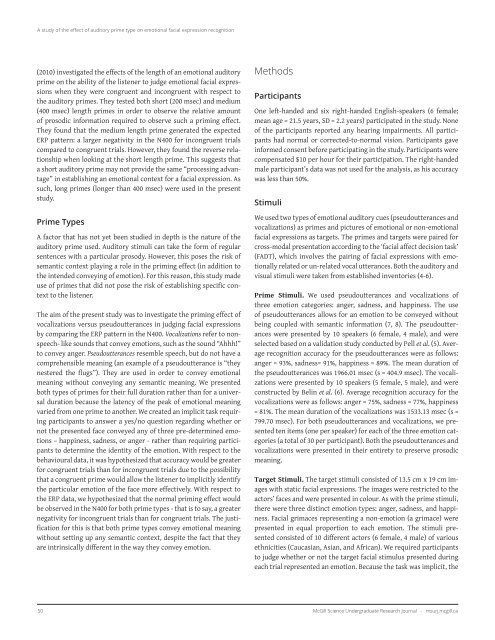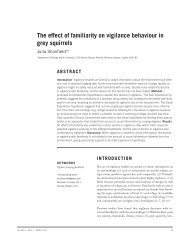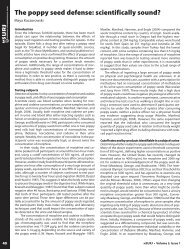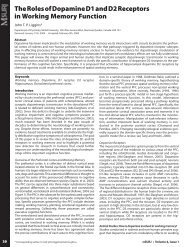the entire issue - McGill Science Undergraduate Research Journal ...
the entire issue - McGill Science Undergraduate Research Journal ...
the entire issue - McGill Science Undergraduate Research Journal ...
Create successful ePaper yourself
Turn your PDF publications into a flip-book with our unique Google optimized e-Paper software.
A study of <strong>the</strong> effect of auditory prime type on emotional facial expression recognition<br />
(2010) investigated <strong>the</strong> effects of <strong>the</strong> length of an emotional auditory<br />
prime on <strong>the</strong> ability of <strong>the</strong> listener to judge emotional facial expressions<br />
when <strong>the</strong>y were congruent and incongruent with respect to<br />
<strong>the</strong> auditory primes. They tested both short (200 msec) and medium<br />
(400 msec) length primes in order to observe <strong>the</strong> relative amount<br />
of prosodic information required to observe such a priming effect.<br />
They found that <strong>the</strong> medium length prime generated <strong>the</strong> expected<br />
ERP pattern: a larger negativity in <strong>the</strong> N400 for incongruent trials<br />
compared to congruent trials. However, <strong>the</strong>y found <strong>the</strong> reverse relationship<br />
when looking at <strong>the</strong> short length prime. This suggests that<br />
a short auditory prime may not provide <strong>the</strong> same “processing advantage”<br />
in establishing an emotional context for a facial expression. As<br />
such, long primes (longer than 400 msec) were used in <strong>the</strong> present<br />
study.<br />
Prime Types<br />
A factor that has not yet been studied in depth is <strong>the</strong> nature of <strong>the</strong><br />
auditory prime used. Auditory stimuli can take <strong>the</strong> form of regular<br />
sentences with a particular prosody. However, this poses <strong>the</strong> risk of<br />
semantic context playing a role in <strong>the</strong> priming effect (in addition to<br />
<strong>the</strong> intended conveying of emotion). For this reason, this study made<br />
use of primes that did not pose <strong>the</strong> risk of establishing specific context<br />
to <strong>the</strong> listener.<br />
The aim of <strong>the</strong> present study was to investigate <strong>the</strong> priming effect of<br />
vocalizations versus pseudoutterances in judging facial expressions<br />
by comparing <strong>the</strong> ERP pattern in <strong>the</strong> N400. Vocalizations refer to nonspeech-<br />
like sounds that convey emotions, such as <strong>the</strong> sound “Ahhh!”<br />
to convey anger. Pseudoutterances resemble speech, but do not have a<br />
comprehensible meaning (an example of a pseudoutterance is “<strong>the</strong>y<br />
nestered <strong>the</strong> flugs”). They are used in order to convey emotional<br />
meaning without conveying any semantic meaning. We presented<br />
both types of primes for <strong>the</strong>ir full duration ra<strong>the</strong>r than for a universal<br />
duration because <strong>the</strong> latency of <strong>the</strong> peak of emotional meaning<br />
varied from one prime to ano<strong>the</strong>r. We created an implicit task requiring<br />
participants to answer a yes/no question regarding whe<strong>the</strong>r or<br />
not <strong>the</strong> presented face conveyed any of three pre-determined emotions<br />
– happiness, sadness, or anger - ra<strong>the</strong>r than requiring participants<br />
to determine <strong>the</strong> identity of <strong>the</strong> emotion. With respect to <strong>the</strong><br />
behavioural data, it was hypo<strong>the</strong>sized that accuracy would be greater<br />
for congruent trials than for incongruent trials due to <strong>the</strong> possibility<br />
that a congruent prime would allow <strong>the</strong> listener to implicitly identify<br />
<strong>the</strong> particular emotion of <strong>the</strong> face more effectively. With respect to<br />
<strong>the</strong> ERP data, we hypo<strong>the</strong>sized that <strong>the</strong> normal priming effect would<br />
be observed in <strong>the</strong> N400 for both prime types - that is to say, a greater<br />
negativity for incongruent trials than for congruent trials. The justification<br />
for this is that both prime types convey emotional meaning<br />
without setting up any semantic context, despite <strong>the</strong> fact that <strong>the</strong>y<br />
are intrinsically different in <strong>the</strong> way <strong>the</strong>y convey emotion.<br />
Methods<br />
Participants<br />
One left-handed and six right-handed English-speakers (6 female;<br />
mean age = 21.5 years, SD = 2.2 years) participated in <strong>the</strong> study. None<br />
of <strong>the</strong> participants reported any hearing impairments. All participants<br />
had normal or corrected-to-normal vision. Participants gave<br />
informed consent before participating in <strong>the</strong> study. Participants were<br />
compensated $10 per hour for <strong>the</strong>ir participation. The right-handed<br />
male participant’s data was not used for <strong>the</strong> analysis, as his accuracy<br />
was less than 50%.<br />
Stimuli<br />
We used two types of emotional auditory cues (pseudoutterances and<br />
vocalizations) as primes and pictures of emotional or non-emotional<br />
facial expressions as targets. The primes and targets were paired for<br />
cross-modal presentation according to <strong>the</strong> ‘facial affect decision task’<br />
(FADT), which involves <strong>the</strong> pairing of facial expressions with emotionally<br />
related or un-related vocal utterances. Both <strong>the</strong> auditory and<br />
visual stimuli were taken from established inventories (4-6).<br />
Prime Stimuli. We used pseudoutterances and vocalizations of<br />
three emotion categories: anger, sadness, and happiness. The use<br />
of pseudoutterances allows for an emotion to be conveyed without<br />
being coupled with semantic information (7, 8). The pseudoutterances<br />
were presented by 10 speakers (6 female, 4 male), and were<br />
selected based on a validation study conducted by Pell et al. (5). Average<br />
recognition accuracy for <strong>the</strong> pseudoutterances were as follows:<br />
anger = 93%, sadness= 91%, happiness = 89%. The mean duration of<br />
<strong>the</strong> pseudoutterances was 1966.01 msec (s = 404.9 msec). The vocalizations<br />
were presented by 10 speakers (5 female, 5 male), and were<br />
constructed by Belin et al. (6). Average recognition accuracy for <strong>the</strong><br />
vocalizations were as follows: anger = 75%, sadness = 77%, happiness<br />
= 81%. The mean duration of <strong>the</strong> vocalizations was 1533.13 msec (s =<br />
799.70 msec). For both pseudoutterances and vocalizations, we presented<br />
ten items (one per speaker) for each of <strong>the</strong> three emotion categories<br />
(a total of 30 per participant). Both <strong>the</strong> pseudoutterances and<br />
vocalizations were presented in <strong>the</strong>ir <strong>entire</strong>ty to preserve prosodic<br />
meaning.<br />
Target Stimuli. The target stimuli consisted of 13.5 cm x 19 cm images<br />
with static facial expressions. The images were restricted to <strong>the</strong><br />
actors’ faces and were presented in colour. As with <strong>the</strong> prime stimuli,<br />
<strong>the</strong>re were three distinct emotion types: anger, sadness, and happiness.<br />
Facial grimaces representing a non-emotion (a grimace) were<br />
presented in equal proportion to each emotion. The stimuli presented<br />
consisted of 10 different actors (6 female, 4 male) of various<br />
ethnicities (Caucasian, Asian, and African). We required participants<br />
to judge whe<strong>the</strong>r or not <strong>the</strong> target facial stimulus presented during<br />
each trial represented an emotion. Because <strong>the</strong> task was implicit, <strong>the</strong><br />
50<br />
<strong>McGill</strong> <strong>Science</strong> <strong>Undergraduate</strong> <strong>Research</strong> <strong>Journal</strong> - msurj.mcgill.ca









